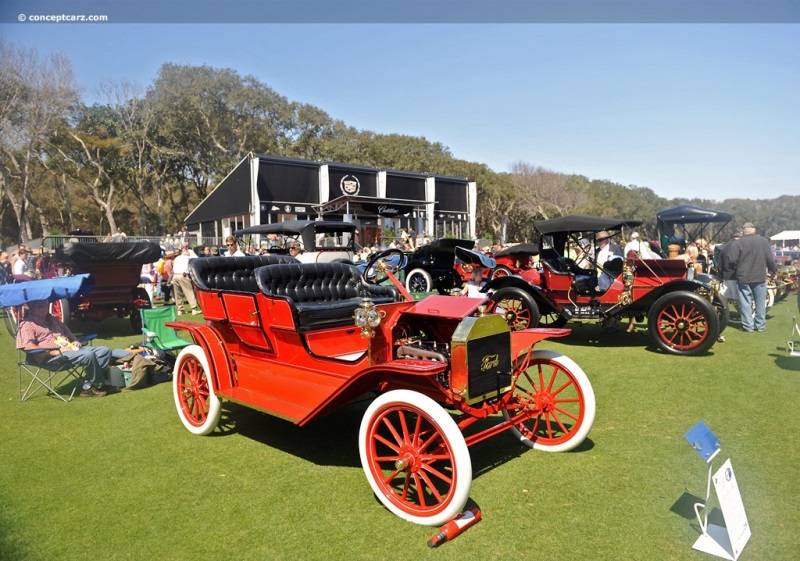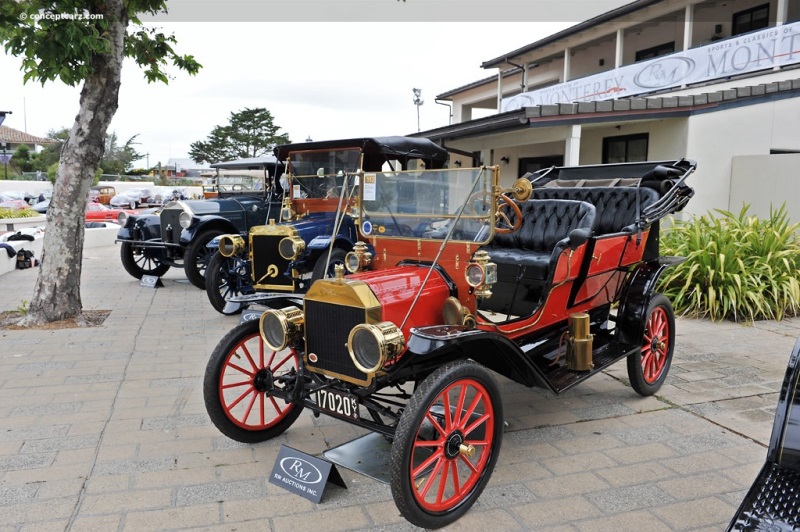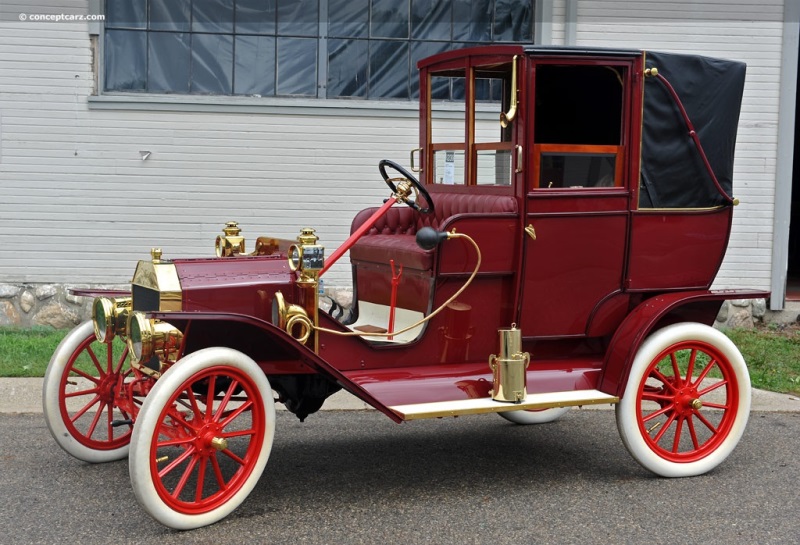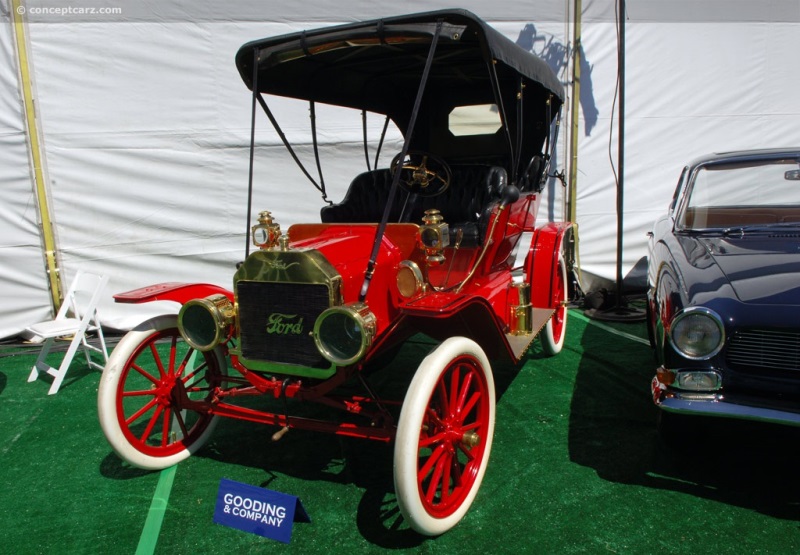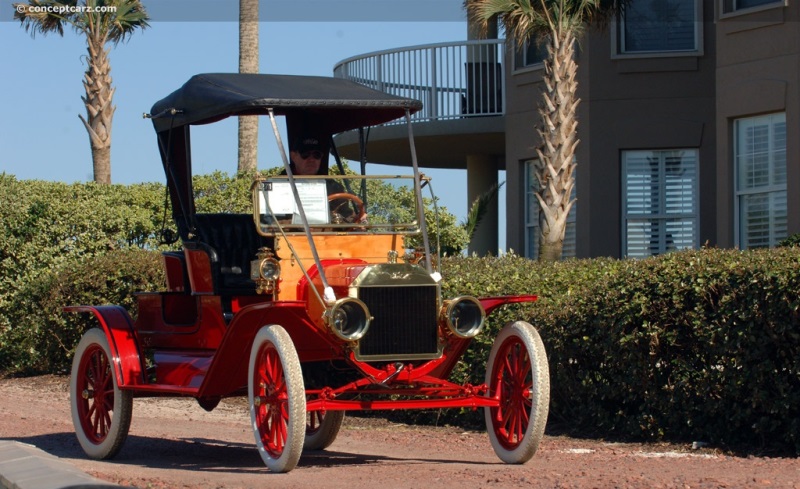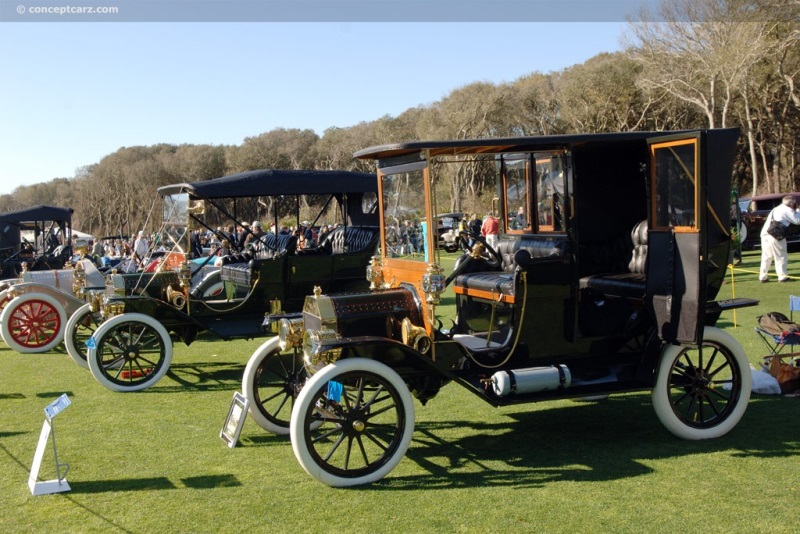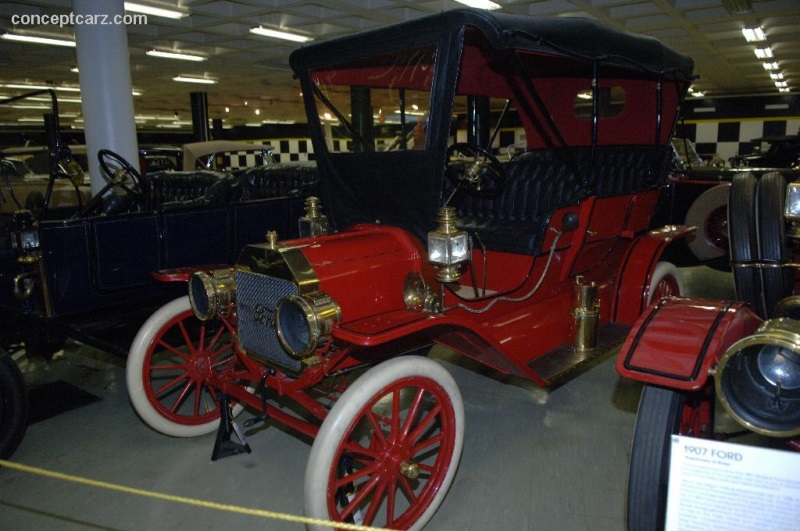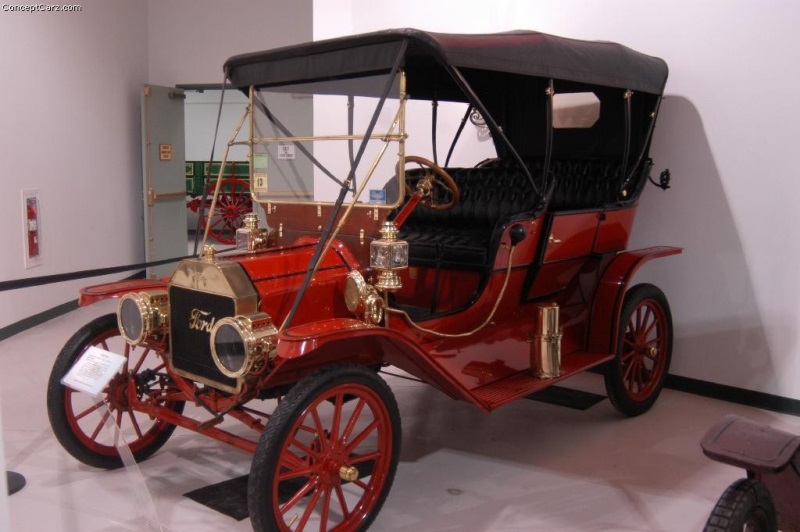After nearly two decades of production, the Model T had fundamentally changed the world, revolutionized automobile production, and ushered in a new means of transportation that all households could afford. The Model T's lineage could clearly be seen in the earlier N, R, and S Models. The frame was made of wood and vanadium steel, which was strong as well as light, and the wheelbase measured 100-inches. It was motivated by a 176.7 cubic-inch four-cylinder offering 22 horsepower and backed by a two-speed planetary transmission, similar to that on a Model N, but completely enclosed in a steel crankcase which also held the engine assembly. The engine's mono-bloc design had an industry-first removable cylinder head and the transmission contained a built-in power supply which became the high tension magneto that would power the ignition coils. 
Towncar
Chassis #: 5321
View info and historyThe first Model T was produced on August 12th of 1908 and left the Ford Piquette Avenue Plant in Detroit, Michigan on September 27th of that year. By the time the final Model T rolled out of the Highland Park, Michigan factory on May 26th of 1927, approximately 15 million examples had been sold. By 1918, half of all the cars in the U.S. were Model Ts. It was the most sold car in history before the Volkswagen Beetle's sales surpassed it in 1972. It was named the most influential car of the 20th century in the 1999 Car of the Century competition.The Ford Model T was inexpensive, readily available, and transformed the automobile industry and the way Americans lived. It was durable, easy to operate, and competitively priced. Mass-produced on moving assembly lines with completely interchangeable parts, the Model T was designed and marketed to the middle class. Propelling the Ford Motor Company to the forefront of American automobile manufacturers, the Model T was often called the 'Tin Lizzie' and the 'Flivver.' The Model T was relatively unchanged throughout its existence, with only minor updates as the American automotive landscape took shape, including moving the steering wheel from the right-hand side of the car to the left, which greatly improved the confidence of drivers commuting the ever-congesting byways and boulevards of America. Brass eventually gave way to nickel in 1917 to accommodate economy of scale production ad to boost profits, which in the volume that the Model T was in 1923 was over two million. Early examples of the Model T had a two-lever, two-pedal system of control, soon replaced by a three-pedal, one lever arrangement. The Ford Motor Company
The Ford Motor Company was incorporated on June 16th of 1903, and this was not Henry Ford's first attempt at a car manufacturing company. The Henry Ford Company had been established a few years earlier, on November 3rd of 1901, from the reorganization of the Detroit Automobile Company. Due to disputes between Ford and his investors, Mr. Ford left in 1902. Later that year, the Ford Motor Company was reorganized as the Cadillac Automobile Company under the guidance of Henry M. Leland.
Towncar
Chassis #: 5321
View info and historyFord's models produced between 1903 and 1908 were dubbed the Models A, B, C, F, K, N, R, and S. Not all of these models entered production with the model immediately preceding the Model T being the Model S. Production of these models typically hovered in the hundreds or thousands, but never in the quantities or success achieved by the Model T. Although Ford's models had been alphabetical per their introduction, the model that proceeded the Model T was named the Model A, rather than the Model U. The Ford Motor Company declared this new car was such a dramatic departure from the old that Ford wanted to re-strat the naming scheme with the letter A.Specifications
A pair of Hungarian immigrants, Joseph A. Galamb and Eugene Farkas were the individuals responsible for the design of the Model T, along with an American engineer named Childe Harold Wills. Additional members of the team included Peter E. Martin, Gus Degner, Henry Love, and C.J. Smith. The Model T was successful because it was simple and effective. Its 177 cubic-inch inline four-cylinder engine was placed at the front and offered 20 horsepower, giving the utilitarian vehicle a top speed of 42 mph. The fuel economy, per the Ford Motor Company, was stated to be in the 13 to 21 mpg range. The engines were able to operate on kerosene, ethanol, or gasoline with the first 2,447 examples being cooled with water pumps prior to the adoption of thermosiphon action. A low-voltage magneto was incorporated in the flywheel, producing alternating current for the trembler (buzz coils - an ignition coil) coils to drive the spark plugs. This setup allowed the Model T to operate regardless of the quality or type of fuel it used. A hand-crank generated current for starting, which meant a battery was not needed. In 1915, electric lighting powered by the magneto was adopted, replacing the previous oil lamps and acetylene gas flame lamps. Although electric starting had been introduced in 1912 (by Cadillac), the Model T did not offer the technology until 1919.
TourerThe engine was backed by a planetary gear transmission, billed as a 'three speed,' with two forward and one reverse. Three floor-mounted pedals and a lever mounted to the roadside of the driver's seat were used to operate the transmission, with the throttle being controlled by a lever on the steering wheel. The transmission was engaged by operating the left-hand pedal, and reverse was controlled by the central pedal - albeit, the first 800 examples had their reverse operated via a lever. The right-hand pedal operated the transmission brake, operating a band around a drum in the transmission, as these were the only brakes on the wheels. The floor lever's position determined the low, high, neutral (intermediate position), or reverse gear, and it controlled the parking brake (activated by pulling the lever all the way back). With the parking brake lever engaged, it operated band brakes acting on the inside of the rear brake drums, which were an integral part of the rear wheel hubs. The single universal joint attached to a torque tube sent power to the differential which drove the rear axle. The front axle was drop forged as a single piece of vanadium steel. The suspension was a transversely mounted semi-elliptical spring for each of the front and rear beam axles. The wheels were wooden artillery types, with steel welded-spoke wheels available during the final two years of production (1926 and 1927). The 30-inch diameter tires were pneumatic clincher type measuring 3.5-inches wide at the rear and 3-inches in the front. Balloon tires became available in 1925. All tires used an inner tube and usually a PSI rating of 60 for the clincher type and around 35 psi for the balloon tires. Between 1908 to 1913, the Model T was not available in black; available colors included red, blue, gray, and green. Gray was available for the town cars, red for the touring cars, and green was for the touring cars, town cars, landaulets, and coupes. By 1912, all cars were being painted midnight blue with black fenders. Beginning in 1914, the Model T was famously offered in 'any color so long as it is black.' The use of black paint was due to its low cost, faster drying time, and durability. 
Landaulet
Chassis #: 3300
View info and history
Auction entries : 1The Ford Model T was originally priced at $600 when the first examples left the factory in 1908, but as production ended in 1927, the Model T was available new for as little as $260.Production Updates
The Ford Model T went through several significant changes throughout its production lifespan, yet it remained the Model T, with no further designation changes to indicate the updates. 1909 through 1914
The Model T produced from 1909 through 1914 had acetylene gas flame headlights and a five-sided hood with two side sloping sections containing the folding hinges, and a flat top with a center hinge. It had no distinct cowl and the firewall was flat beneath the windshield. The fuel tank was located under the front seat.
Roadster
Chassis #: 25131915 through 1916
Minor styling updates arrived in 1915, with the hood gaining louvers to the vertical sides, and electric headlights replaced carbide units. The windshield was repositioned behind the firewall and joined with a compound-contoured cowl panel. 1917 through 1923
Changes were once again made to the hood, now having a tapered design with a curved top. The hood was now aligned with the firewall, with no part of the flat firewall being visible outside of the hood. New bodies were introduced in August 1922. They were lower than the earlier cars and the radiators were taller. The luggage compartments on the coupes were integrated into the body, while the roadster body style had a separate unit that could be removed for commercial use if desired. Open cars had a windshield raked back at an angle and a new 'one-man' top.
Towncar
Chassis #: 5321
View info and history1923 through 1925
The taper of the hood increased slightly and the rear section at the firewall was now approximately an inch taller and several inches wider than the previous design.1926 through 1927
The hood was enlarged and the cowl panel no longer had a compound curve. Production
Sales of the Model T increased significantly nearly every year during its first decade of production. 10,666 examples were produced in 1908 and nearly doubled the following year, to 19,050. Production grew to 34,858 in 1911 and increased to 68,773 units in 1912. Model T production eclipsed 100,000 units (to 170,211 units) in 1913, and then to 202,667 units in 1914. By 1917, sales had reached 735,020 units, dipping slightly the following year to 664,076 units, then falling again to 498,342 units in 1919 before increasing significantly to 941,042 units in 1920. The best year of production was 1923 with 2,011,125 units built. The previous year had been the first year the Model T eclipsed the magical million-dollar mark, with 1,301,067 units built. Between 1922 to 1926, over a million examples were built each year. By the time production had come to an end, approximately 14,689,525 Model T's had been built. Henry Ford and his son Edsel drove the final Model T out of the factory on May 26th of 1927. This was the automobile's official last day of production at the main factory.
by Daniel Vaughan | Apr 2022
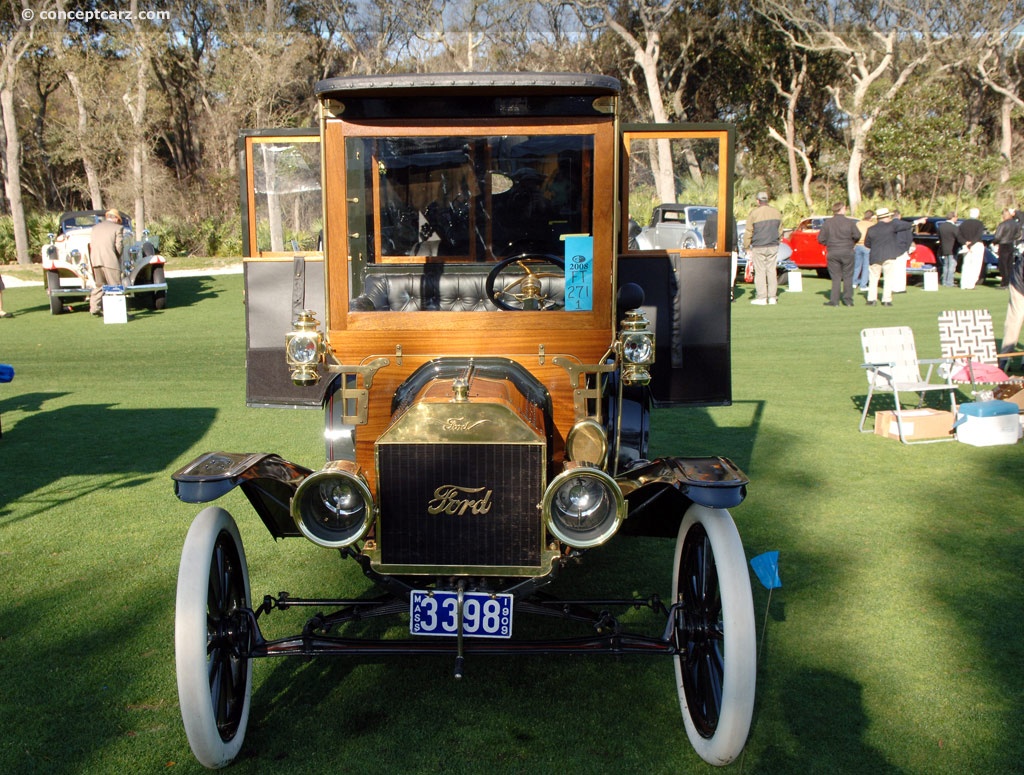
Towncar
Chassis #: 5321
View info and history
The Ford Motor Company was incorporated on June 16th of 1903, and this was not Henry Ford's first attempt at a car manufacturing company. The Henry Ford Company had been established a few years earlier, on November 3rd of 1901, from the reorganization of the Detroit Automobile Company. Due to disputes between Ford and his investors, Mr. Ford left in 1902. Later that year, the Ford Motor Company was reorganized as the Cadillac Automobile Company under the guidance of Henry M. Leland.
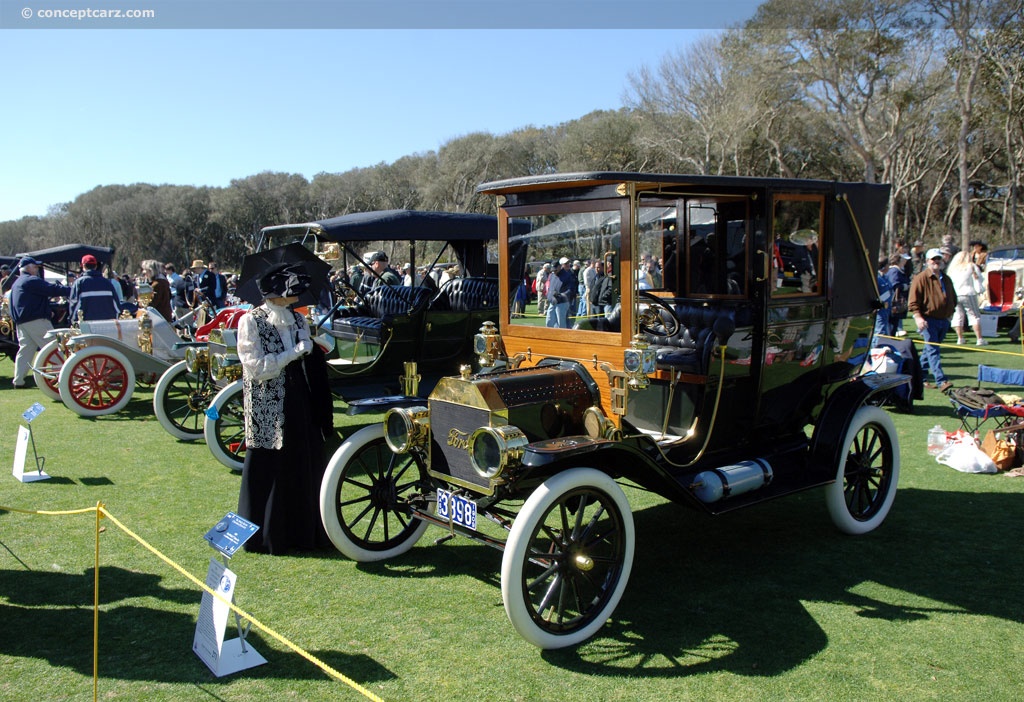
Towncar
Chassis #: 5321
View info and history
A pair of Hungarian immigrants, Joseph A. Galamb and Eugene Farkas were the individuals responsible for the design of the Model T, along with an American engineer named Childe Harold Wills. Additional members of the team included Peter E. Martin, Gus Degner, Henry Love, and C.J. Smith. The Model T was successful because it was simple and effective. Its 177 cubic-inch inline four-cylinder engine was placed at the front and offered 20 horsepower, giving the utilitarian vehicle a top speed of 42 mph. The fuel economy, per the Ford Motor Company, was stated to be in the 13 to 21 mpg range. The engines were able to operate on kerosene, ethanol, or gasoline with the first 2,447 examples being cooled with water pumps prior to the adoption of thermosiphon action. A low-voltage magneto was incorporated in the flywheel, producing alternating current for the trembler (buzz coils - an ignition coil) coils to drive the spark plugs. This setup allowed the Model T to operate regardless of the quality or type of fuel it used. A hand-crank generated current for starting, which meant a battery was not needed. In 1915, electric lighting powered by the magneto was adopted, replacing the previous oil lamps and acetylene gas flame lamps. Although electric starting had been introduced in 1912 (by Cadillac), the Model T did not offer the technology until 1919.
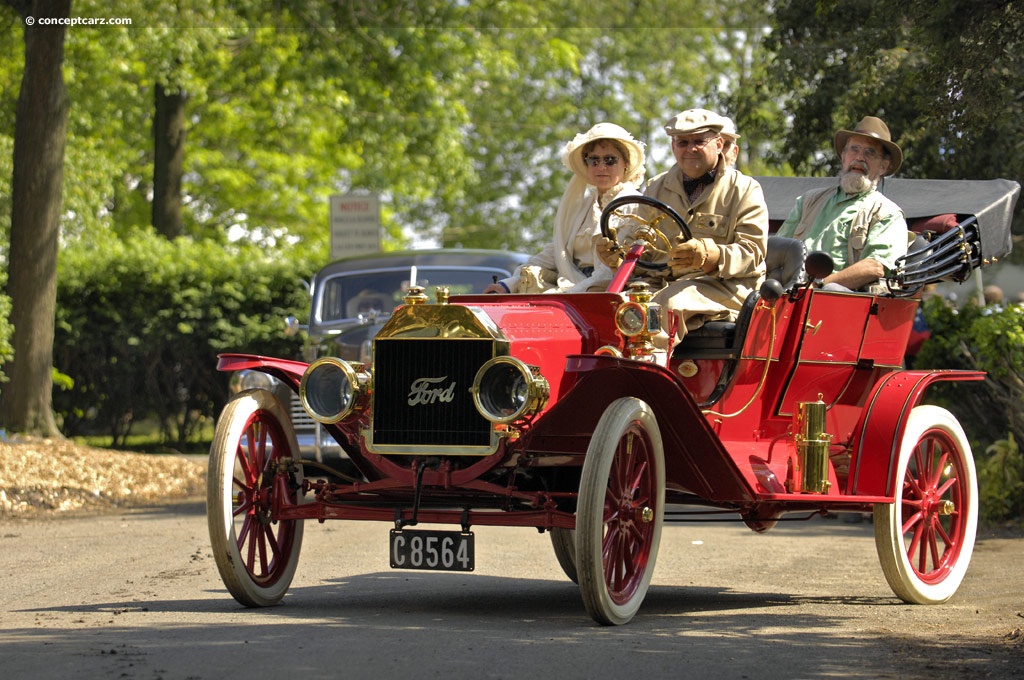
Tourer
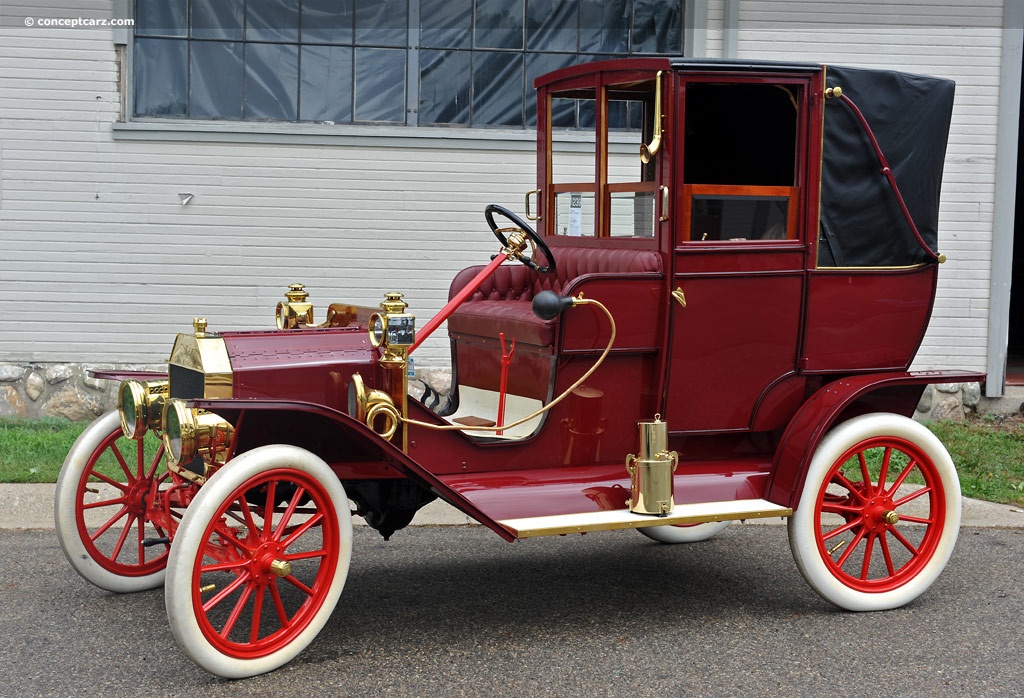
Landaulet
Chassis #: 3300
View info and history
Auction entries : 1
The Ford Model T went through several significant changes throughout its production lifespan, yet it remained the Model T, with no further designation changes to indicate the updates. 1909 through 1914
The Model T produced from 1909 through 1914 had acetylene gas flame headlights and a five-sided hood with two side sloping sections containing the folding hinges, and a flat top with a center hinge. It had no distinct cowl and the firewall was flat beneath the windshield. The fuel tank was located under the front seat.
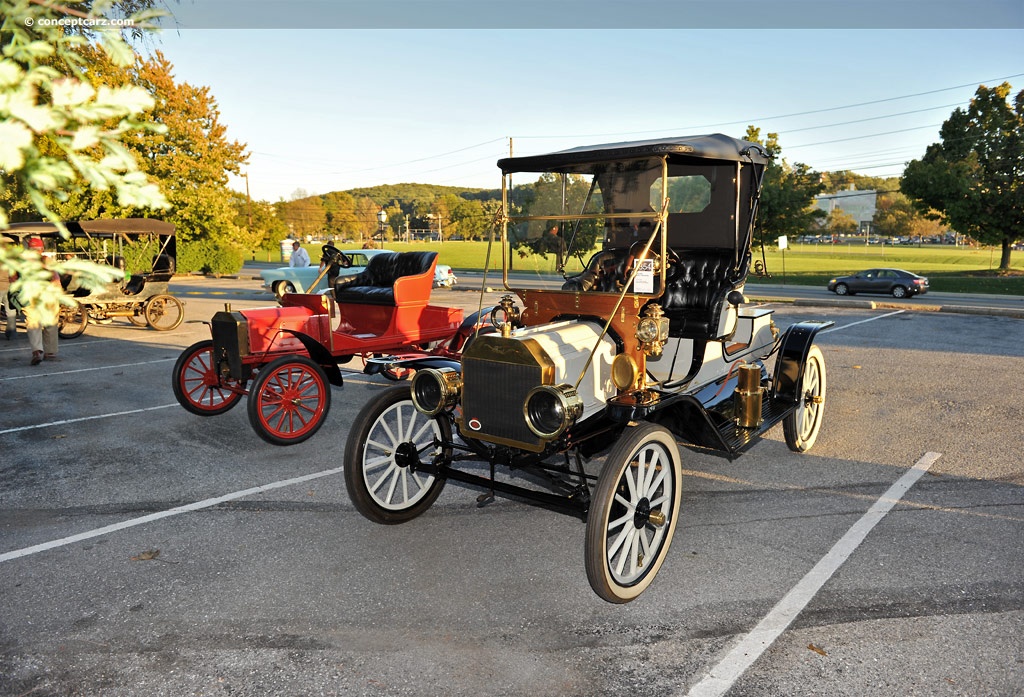
Roadster
Chassis #: 2513
Minor styling updates arrived in 1915, with the hood gaining louvers to the vertical sides, and electric headlights replaced carbide units. The windshield was repositioned behind the firewall and joined with a compound-contoured cowl panel. 1917 through 1923
Changes were once again made to the hood, now having a tapered design with a curved top. The hood was now aligned with the firewall, with no part of the flat firewall being visible outside of the hood. New bodies were introduced in August 1922. They were lower than the earlier cars and the radiators were taller. The luggage compartments on the coupes were integrated into the body, while the roadster body style had a separate unit that could be removed for commercial use if desired. Open cars had a windshield raked back at an angle and a new 'one-man' top.
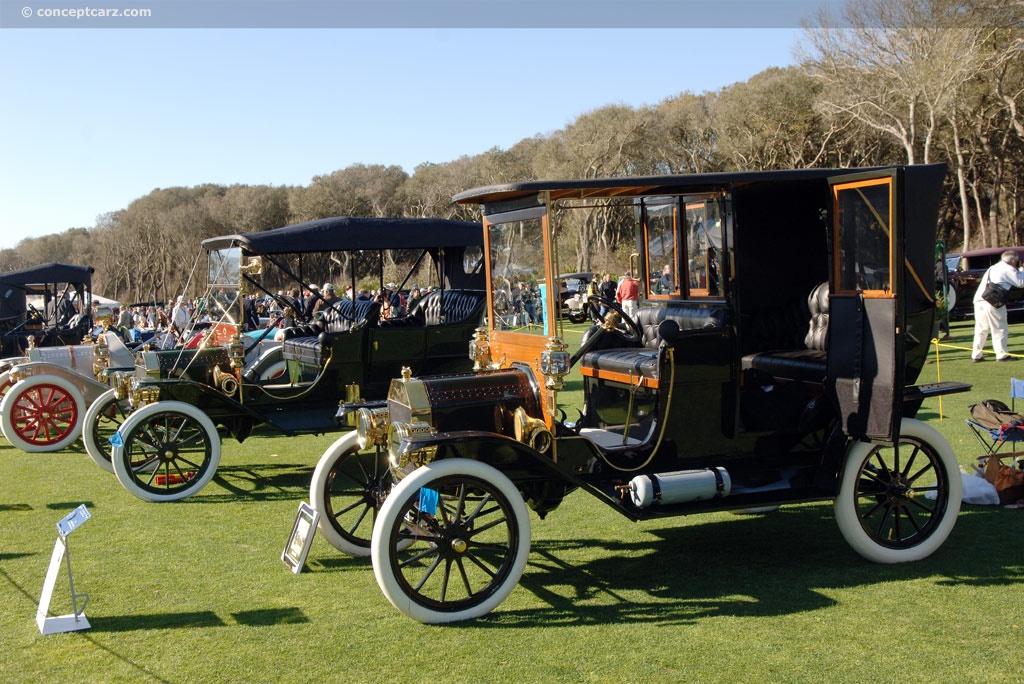
Towncar
Chassis #: 5321
View info and history
The taper of the hood increased slightly and the rear section at the firewall was now approximately an inch taller and several inches wider than the previous design.1926 through 1927
The hood was enlarged and the cowl panel no longer had a compound curve. Production
Sales of the Model T increased significantly nearly every year during its first decade of production. 10,666 examples were produced in 1908 and nearly doubled the following year, to 19,050. Production grew to 34,858 in 1911 and increased to 68,773 units in 1912. Model T production eclipsed 100,000 units (to 170,211 units) in 1913, and then to 202,667 units in 1914. By 1917, sales had reached 735,020 units, dipping slightly the following year to 664,076 units, then falling again to 498,342 units in 1919 before increasing significantly to 941,042 units in 1920. The best year of production was 1923 with 2,011,125 units built. The previous year had been the first year the Model T eclipsed the magical million-dollar mark, with 1,301,067 units built. Between 1922 to 1926, over a million examples were built each year. By the time production had come to an end, approximately 14,689,525 Model T's had been built. Henry Ford and his son Edsel drove the final Model T out of the factory on May 26th of 1927. This was the automobile's official last day of production at the main factory.
by Daniel Vaughan | Apr 2022
Related Reading : Ford Model T History
The Ford Model T has an extensive history in the automotive market lasting for nearly 20 years. It is often called the Tin Lizzie and the Flivver and is credited with putting America on wheels. During the early 1900s, the automobile was very new and the marketplace was adjusting to having these horseless carriages carry its passengers rather than bicycles or horses. Steam, electricity, and....
Continue Reading >>
Continue Reading >>
Similarly Priced Vehicles
1909 Ford Model T Vehicle Profiles
Recent Vehicle Additions
Performance and Specification Comparison
Price Comparison
Model T Specification Comparison by Year
Year
Production
Wheelbase
Engine
Prices
Related Automotive News

Renowned Don C. Boulton Collection Of Brass Era Automobiles Heads To Amelia Island
Bonhams is very pleased to announce the sale of the Don C. Boulton Collection of two dozen Pioneer, Veteran and Brass Era automobiles and automobilia at the Amelia Island Auction on March 7th.
The late Don Boulton of Oklahoma City was renowned for...

Fascinating Early and Classic Era American Collections Set for RM Sotheby's Hershey Sale
RM Sothebys brings two private collections rich in automotive history to its annual Hershey sale, October 8-9 in Pennsylvania
Auction headlined by the Richard Roy Estate Collection, 25 automobiles with strong New Jersey and Pennsylvania ties
E...

PEBBLE BEACH AWARD-WINNING COACHBUILT FERRARI LEADS IMPRESSIVE STABLE OF PRANCING HORSES CONSIGNED FOR BONHAMS QUAIL LODGE AUCTION
Select consignments are now being accepted to join the confirmed roster of top-tier entries
Bonhams renowned mid-August auction at Quail Lodge in Carmel, California, just added another star to its constellation of consignments a 1951 Ferrari...

1960 FERRARI 400 SUPERAMERICA SWB CABRIOLET HEADLINES STUNNING LIST OF EUROPEAN SPORTS-TOURING CARS AT RM'S AMELIA ISLAND SALE
RM Auctions announces additional highlights for its Amelia Island, Florida sale, March 14
Recent entries led by a 1960 Ferrari 400 Superamerica SWB Cabriolet, one of the most valuable automobiles ever offered during the Amelia Island weekend
Th...

Rolex Monterey Motorsports Reunion : A Brilliant Finish
There are times to spectate and there are times to roll up ones sleeves and participate. At the Rolex Monterey Motorsports Reunion this year, both options brought abundant joy, as more than 550 authentic and historic race cars from nearly every decade...






























